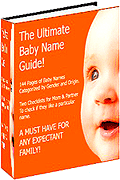Popular Names -
by: Robin Darch
There are always concerns about a baby’s health. Many parents overreact to the smallest problem, but you really can’t be too careful when it comes to your baby’s health. Recognizing the symptoms to the most common diseases is very important to early diagnosis and treatment.
Rubella or German Measles: It’s sometimes referred to as the 3-day measles as well. It affects the skin and lymph nodes. It’s not the same virus that cause measles. It can pass through a pregnant woman’s bloodstream to infect her unborn baby.
Rubella infection may begin with 1 or 2 days of mild fever (99 to 100 degrees Fahrenheit, or 37.2 to 37.8 degrees Celsius) and swollen, tender lymph nodes, usually in the back of the neck or behind the baby’s ears. On the second or third day, a rash appears that begins on the baby’s face and spreads downward. As it spreads down the body, it usually clears on the face. This rash is often the first sign of illness that a parent notices.
The rubella rash can look like many other viral rashes. It appears as either pink or light red spots, which may merge to form evenly colored patches. The rash can itch and lasts up to 3 days. As the rash passes, the affected skin occasionally sheds in very fine flakes.
Its importance is the potential effects on an unborn baby if infection is acquired during early pregnancy.
The introduction of the MMR vaccine has reduced the incidence of primary rubella infection, and the number of severely affected unborn babies. The incubation period is 14-21 days, fever is often mild, and children do not feel particularly unwell, unlike measles infection. Woman who may be pregnant should not come into contact with infected children.
Chickenpox: occurs most often in the late winter and early spring, is very contagious and if exposed to an infected family member, about 80% to 90% of those in a household who haven't had chickenpox will get it. However, immunization of children with the chickenpox vaccine that's now available is expected to decrease cases of the disease dramatically over the next few years.
Although it's more common in kids under the age of 15, anyone, including babies, can get chickenpox. A person usually has only one episode of chickenpox in his or her lifetime. But the virus that causes chickenpox can lie dormant within the body and can cause a different type of skin eruption later in life called shingles, also referred to as herpes-zoster.
It’s usually a mild illness in children. The incubation period is 14-16 days, and there are often no symptoms other than the rash. The rash generally only lasts 8-10 days. Some children develop a mild fever in the first 2-3 days. The spots appear in crops, first as small bumps, and rapidly changing into little blisters. The blisters soon dry and crust, and scabs form over the top. Keep your child from scratching them or it could lead to scarring. Calamine creams are useful to help relieve any itching from the spots.
Roseola Infantum: Affects babies under two. The baby will have a high fever, but appear well otherwise, and 3 or 4 days later the temperature will rapidly drop to normal. At this time, after the fever has gone, a faint rash appears which only lasts 1 or 2 days at most. There are no complications.
Coughs and Colds:
Most children will have at least six respiratory infections each year. These are almost always mild, last only a few days and have no consequences. Children will simply get a blocked, runny nose, may have a mild fever and feel slightly unwell. In young babies (who are nose breathers) feeding can become difficult for a couple of days. Children should be treated with Paracetamol or Ibuprofen if they have a fever, and may be helped by nasal decongestants. There is rarely a need for antibiotics. Occasionally coughing, especially at night times can be the main symptom of asthma, and children with persistent nocturnal coughs should see a doctor.
Sore Throat, Pharingitis and Tonsillitis: Very common between the ages of 4-7 years old. Symptoms include pain while swallowing and eating, earache, and fever. Giving them soft food to eat and lots of fluids. Children should see a doctor if they have a fever too. Pharyngitis is caused by viruses and so will not always require antibiotic treatment. Tonsillectomies are rarely performed now.
Earache: Very common in children and babies. It can be associated or caused by chest infections, colds and coughs. Sometimes there is no infection in the ear, pain is due to the Eustachian Tube being blocked. When blocked it doesn’t maintain the correct pressure in the ear.
Where there is a true infection, Otits Media, or Middle Ear Infection, the eardrum becomes red and inflamed and can cause the baby to have a fever. Babies may become irritable or hold their hands over their ears. If you suspect your baby has an ear infection, you should see a doctor.
Vomiting and Diarrhea: Very common, especially if you take your baby on travels to foreign countries. In the US and other developed nations, vomiting and diarrhea are commonly caused by viral infections. and Diarrhea will often be watery. It may be difficult to distinguish from urine in a nappy.
Your baby or child will usually only be sick a very short time. It is important to treat them right away to avoid your baby becoming dehydrated. Younger babies are more vulnerable than older children.
(continued...)
Health Tips For Your Baby
Page 2
About The Author
Robin Darch, of PRT Specialised Services Limited has a website, http://www.babyport.info to help parents find all the information they need about babies, baby names, baby showers, baby gifts, products for babies, baby clothing, and more. There is also more about baby gifts at http://www.babyport.info/42831.php Chris McElroy runs a missing children’s organization at http://www.kidsearchnetwork.org.
|
